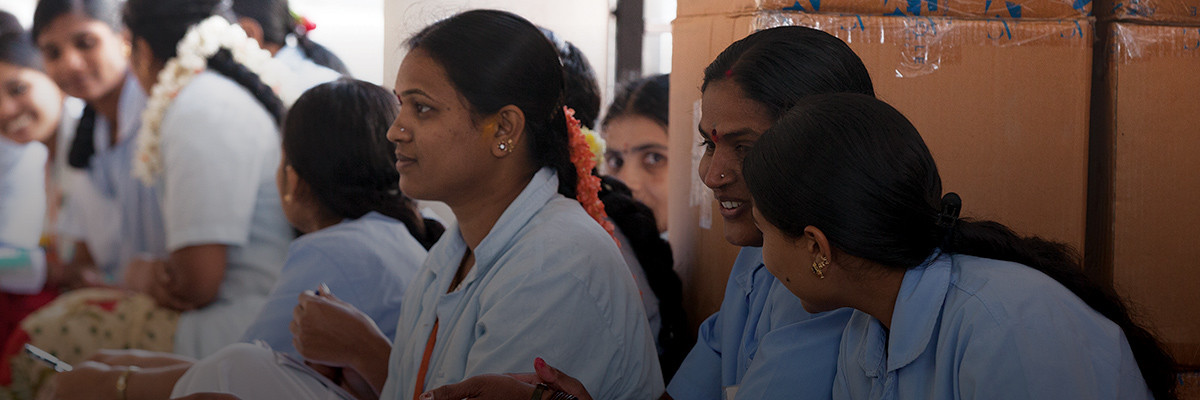
“Once I brought a condom back to the dormitory, and I used a banana to demonstrate how to use a condom. It was funny. We all laughed a lot. They did not know it was a condom; they thought it was a kind of protective finger glove. But now they all know how to use a condom.”
This kind of scene might feel far removed from the conversations had by the eminent global leaders of the UN Secretary-General’s High-Level Panel on Women’s Economic Empowerment this week in New York. But for China’s Wang Cihui, like many low-income women workers in global factories, family planning is an essential starting point to pursue her goals and ambitions. Wang Cihui’s story is an example of how the recommendations of the High-Level Panel’s first report, released today, translate to real life.
What I find exciting in the High-Level Panel report is a challenge for business to go beyond “just” getting women into jobs that will help the global economy grow—as the oft-cited McKinsey stat has it, to the tune of US$28 trillion in GDP growth. The report recognizes and highlights the systemic constraints that limit women’s economic empowerment, such as adverse social norms, discriminatory laws, and gender gaps in access to digital, financial, and property assets.
And the High-Level Panel recommendations to business are similarly bold and broad: The report urges businesses to invest in initiatives that, for example, reduce and redistribute unpaid care and work, and to work on financial and digital inclusion for women. BSR’s new report “Women’s Empowerment in Global Value Chains,” produced with support from Women Deliver and the Ministry of Foreign Affairs of the Netherlands, is a good starting point for practical suggestions on how companies can go about investing in women’s health, rights, and well-being—which will unlock business opportunities.
Workplaces as Drivers of Empowerment
While the High-Level Panel report deserves huge credit for looking beyond the workplace to tackle systemic barriers, our experience at BSR is that the workplace can in fact be an interesting space to promote women’s economic empowerment in precisely this broad and far-reaching way. That’s because workplaces can uphold systemic discrimination of female workers by keeping them in the lowest-paid jobs, on casual incomes, and enduring daily sexual harassment. Or they can be a space for change.
For nearly 10 years, HERproject has partnered with more than 50 global brands to deliver programs designed to empower women in factories and farms. In that time, we have learned a number of lessons:
- The formal nature of the workplace makes it a good entry point for tackling systemic challenges. Industries dominated by women, such as the garment industry or horticulture, bring together thousands of women every day of the working week. This offers a potential space to reset gender norms that hold women back. One way to do this is through tailored training and programs that create a mass push for women’s empowerment.
- Local business plays a key role. Achieving progress requires energy and input from several entities, including different teams at global brands’ headquarters and local NGOs with in-depth understanding of local culture. However, without firm buy-in from local business owners, farm managers, and factory supervisors, improvements will not take hold. Changing deep-seated perceptions and practices takes time and requires sustained commitment from both global brands and local business to create a business model that puts women at the center. The reality is that while global brands have a core responsibility in both enabling and influencing positive change for women in their supply chains, local companies—which are at the very center of global supply chains—are the ones translating the recommendations of the High-Level Panel into practical improvements on the factory floor. More attention is required to support those companies to make women’s economic empowerment part and parcel of business as usual.
- Economic empowerment depends on many other kinds of empowerment. For women to have equal opportunity to men in markets, other barriers will need to be confronted, too. If women cannot plan their families, their economic situation will deteriorate. If they are unable to adequately manage their finances, their well-being and that of their family will decrease. And if workplaces fail to prevent harassment and gender-based violence against women, their economic potential will never be realized.
For all of these reasons, HERproject is based on a collaborative, holistic model, bringing together global brands, their suppliers, and local NGOs to tackle systemic challenges in line with several of the Sustainable Development Goals (SDGs). Through the capacity-building and workplace system-strengthening of HERhealth, HERfinance, and HERrespect, HERproject can contribute to: no poverty (SDG1), good health and well-being (SDG3), gender equality (SDG5), and decent work and economic growth (SDG8). Major global brands are recognizing that they have a unique opportunity to contribute to the SDGs throughout their supply chains; by engaging to deliver programs designed to empower women, they can drive impact on a wide range of other areas.
The first High-Level Panel report is highly important, publicly emphasizing the importance of collaborative business action for women’s economic empowerment. We believe that workplaces can be a powerful springboard to support the economic empowerment of women, but we recognize that we can go both deeper and bigger. Now’s the time for others to join the pioneering brands participating in HERproject and to make workplaces a game changer. We look forward to taking that journey with you.
Let’s talk about how BSR can help you to transform your business and achieve your sustainability goals.
